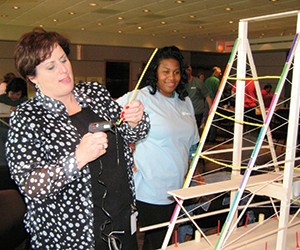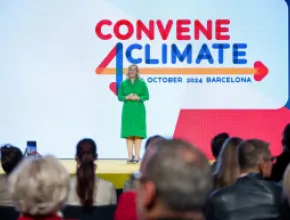Following years of anticipation, there will soon be a clearer answer to the still lingering question: What is a green meeting?
Incurring nearly as much debate as the U.S. health care reform law, the APEX/ASTM Environmentally Sustainable Meetings Standards are in the final stages of review and slated for at least partial release this summer.
The Convention Industry Council’s (CIC) Accepted Practices Exchange (APEX) Panel on Green Meeting and Event Practices last year released its final draft standards for green meetings and events for review and comment by the meetings industry. Developed in collaboration by the U.S. Environmental Protection Agency (EPA), the Green Meeting Industry Council (GMIC) and APEX, the standards were also submitted to ASTM International to become accredited standards upon approval.
Three-Fold Approach
The APEX standards take a three-fold approach to sustainability, considering the economic, environmental and social aspects of meetings and events. The goal is to create a voluntary, industry-wide set of standards that would act as a veritable roadmap for planners and suppliers in organizing sustainable meetings.
New APEX standards for sustainable meetings.
"After two years of planning, discussions, workgroups, region meetings and review by more than 200 industry volunteers and professional standards writers, the APEX standard is scheduled for release in [August]," says Michael Luehrs, sustainability services manager for the MCI Headquarters Office in Stockholm. Luehrs served as a committee member on the venues group and the accommodations group during the development of the standards.
"One could say they are in effect nine standards, covering nine areas unique to the meetings industry: accommodations, audiovisual and production, communications and marketing, destinations, exhibits, food and beverage, meeting venue, on-site offices and transportation," he explains. "Because each of the nine areas was subject to its own committee of professionals and had different degrees of complexity, each section has taken a different amount of time to complete."
Amy Spatrisano, principal of Portland, Ore.-based MeetGreen and co-founder of GMIC, explains how the concept for an industry standard was born. An EPA bill put before the House of Representatives in 2007 included components about green meetings, which were eventually cut from the bill when it passed.
"That was good it didn’t pass, because no industry person participated in the writing of the bill," she recalls. "I heard about it and contacted the EPA contact we have through GMIC to see how we could collaborate on this. I provided them with names of industry people who could be involved. ... APEX found out about the work we were doing and asked whether they could ‘crash the party’."
The EPA wanted to be sure the standards were developed by an ANSI (American National Standards Institute) certified organization and recommended ASTM, one of the largest standards development and delivery systems in the world. Spatrisano agreed to chair the green meetings and events practice panel for APEX and collaborate with ASTM to develop the standards.
"This was supposed to have been passed last year," Spatrisano says. "I was very naive when I took on this role. What seemed simple really wasn’t. We’re really setting groundwork for our industry."
Six sectors have been approved by ASTM while the remaining three—meeting venue, food and beverage and accommodations—are currently under review. According to Spatrisano, the first six are slated for August release and the final three in September or early fall.
"The three most problematic are the biggest," Spatrisano says. "Those are the things people think of first. The three largest bodies of work are the most complex."
Part of the delay is the ASTM process itself.
"Every time we ballot the standards the ASTM community has 30 days to comment and we have to respond to every negative comment," says Sue Tinnish, ASTM liaison and chair of the ASTM committee on sustainability.
"There have been hundreds of pages of responses," Spatrisano says. "Any comments negative and positive we had to respond to. The enormity of this project, anyone of us in it doesn’t quite get it yet. Certainly people not involved in it don’t understand what kind of rigor and revolution the standards have gone through."
Tinnish asserts that the quality of the standards have improved by going through the ASTM process. "We’ve had engineers looking at our standards talking to us about biodegradability, about certain kinds of plastic...the kind of detail I’ve had to get involved in. The standards are much more rigorous and they are better, but it hasn’t been without its pain."
Sustainability Levels
According to Tinnish, the standards introduce not only another level of complexity, but also another level to differentiate a meeting and to differentiate suppliers.
"This is just another lens on which to make a decision, but it’s an important lens," she says.
The standards are rated from level one to level four, with four being the highest, as far as levels of sustainability.
"There were challenging conversations around what’s basic enough," Spatrisano explains. "We didn’t want the bar too low or too high. Everyone involved in the process had different levels of expertise, which was good. If it was left to people doing this for a while, the standards would have been too high a level for most to achieve. We all recognize that the standards that will be launched will not be perfect; we expect they will go through a revision process."
Each sector contains separate standards for planners and suppliers, allowing the responsibility for implementation to be shared. Some standards have also been established for CVBs and destinations.
According to Spatrisano, the standards had to be planner and supplier compliable.
"These require both parties to perform," she says. "The supplier can do a fabulous job, but if the supplier recycles and the planner brings in Styrofoam or multiple plastics that the venue cannot recycle, then the facility can’t reach the numbers it needs to keep at a level they want to be on. That’s the planner’s accountability. Two parties have to work together in a different way than they have had to do before."
The standards are designed to be used as a checklist, to reveal what level a planner or supplier is at and what is entailed to get to the next level. For example, with regard to food and beverage, the APEX standards will include an option that the planner request all seafood be sustainable or that carry-out or concession packaging must be compostable and biodegradable.
"People want to know what they need to do to be green," Spatrisano says. "With the standards they know where to start from… a step in reducing their environmental footprint and improving social responsibility."
The APEX standards are not the first to be released. The British Standard BS 8901 was released in 2007 and was developed with a purpose of helping the events industry operate in a more sustainable manner.
"It is important to note that the two standards are different in their approach to defining a sustainable event standard," Spatrisano says. "The BS 8901 standard is a management system written to inform the process of organizing an event, while the APEX standard provides definitions of specific operational actions with key performance measures. The standards will work well independently or in collaboration as frameworks for sustainable events."
The APEX standards are prescriptive, in that they offer guidance in what planners need to do, according to Tinnish.
"That has been a particular challenge in our industry—people don’t know where to start. APEX standards tell you what to do and tend to be more prescriptive to planners than suppliers," she says.
Though there is certainly still a buzz in the green meetings industry, there is some question whether the momentum is still at a peak for green and sustainable meetings.
According to Jessica Ludders, senior project manager of Seattle-based Sound Planning, the buzz is still there.
"Planners are actually clamoring for this kind of standard," she says. "Guidance that has been out there has not been as prescriptive—the BS 80901 standard, I walked Microsoft through that process in 2009. That one doesn’t have the checklist. The APEX standard is very prescriptive and has very clear checklists and clear levels you can be engaged at. Planners I think will be very happy. That’s how a planner’s brain works; we work with to-do lists and checklists."
Luehrs believes that a select group of planners are very eager for the standards, but green is still not on everyone’s radar.
"A larger, less engaged group of planners are not even aware that the standards are about to be released," he says. "There remains a large gap between the industry players who are working to better integrate sustainability and those who perhaps are not interested in changing the way they currently do business. Like television, which eventually offered buyers no option but color, APEX may have the effect of encouraging suppliers to adopt sustainable practices to the degree that, eventually, even without asking, planners will be organizing events which are by current thinking, ‘green’."
Supplier Side
Suppliers are anticipating help from the guidelines. Scott Morgan, senior director of national sales for Kimpton Hotels, believes that many suppliers have created their own standards, including Kimpton Hotels & Restaurants, partially due to the requests from meeting planners.
"However, once the APEX green meeting standards are finalized and introduced to the industry, it will provide a more streamlined approach, so we are all working to provide and offer the same sustainable experience and achieve greater results together as an industry," says Morgan, who served as the chair of the accommodations committee.
Lindsay Smith, sustainable programs manager of Denver’s Colorado Convention Center/SMG, poses that the standards raise the expectations for suppliers now that they know more specifically if they can market themselves as a green supplier.
"The biggest benefit is providing direction, framework and a better understanding for the industry," says Smith, who co-chaired the meeting venue committee. "Right now people are looking for some universal standard and there really isn’t one. There is Green Seal, but that’s more focused on cleaning. LEED certification is for building operations or construction. This is the first standard to focus on all elements of what green meetings, conferences and events entail.
"You see people covering the full gamut regarding what it takes it to be a green event," Smith continues. "Some know how to do it right, using local and organic menus, advanced compost practices. Others consider it a green meeting because they are using recycled paper for programs. This will create more understanding and an expectation for having a green meeting, and if you’re not there yet, how to get there."
What cannot be denied is the major shift in expectations around sustainability and corporate social responsibility (CSR) in the wider world, according to Roger Simons, manager of CSR and sustainable events for MPI.
"We have a duty to ensure our members are prepared and equipped for these developments, and if they are not visible in supplier RFPs currently, then it’s a matter of when rather than if," he says.
Simons reports that in a recent MPI FutureWatch survey of over 1,800 members, more than three-quarters of meeting planners (76 percent) reported that CSR would be a focus for their organizations in 2010, along with 63 percent in the U.S. and 60 percent in Canada. Nearly three-quarters of corporate planners and over 48 percent of association planners said CSR will be on their organizations’ radars over the next year. Among suppliers, CSR is a focus for 67 percent of respondents in EMEA and 61 percent in North America.
According to Simons, MPI will be launching a Sustainable Event Measurement tool at its World Education Congress (WEC) in Vancouver this July. The tool will be available free for members and have planner and supplier functionality at both basic and advanced levels.
"It will allow members to have an easy-to-use system to prepare for probable regulatory compliance around carbon reporting, track their improvement of events and benchmark their reduced environmental footprint," he says.
The first training around the APEX standards will take place just prior to the MPI WEC, including how to use the standards and how they impact an organization. GMIC is spearheading the training and with the help of CIC is creating a certification program for planners and suppliers.
"Certification will be similar to CMP certification in a very general sense," Spatrisano says. "But we have to get the standards out there first. The certification is a good year and half away."







